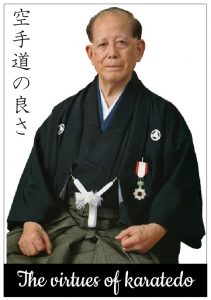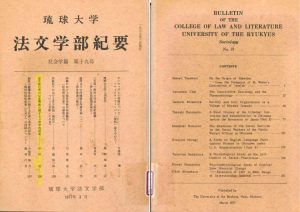
Without succumbing to many pressures, the karatedō left by our Okinawan ancestors has been cultivated over a thousand years and has discovered the truth of "Karate ni sente nashi " – There is no first attack in karate". I am convinced that real world peace will be achieved if the veracity of "Karate ni sente nashi” is demonstrated without changing both now and in the future.
The virtues of karatedō:
- Karate can be practiced alone, but can also be practiced by many people together.
- Karate can be practiced freely by anyone that is to say children, seniors, men and women alike.
- Karate training can be either vigorous or light depending on one’s physical strength.
- Karate training can be done even in a narrow space.
- Karate gives courage to those who lack it and willpower to those who lack it.
- Karate promotes health and doubles work efficiency.
- Karate makes life brighter ensuring longevity and peace.
What country in the world possesses such an ideal cultural property? It is a wonder that in such a small island nation, through a long history, karate has survived to the present day according to the words of the ancestors "truth withstands winds".
December 10, 1967
The 1st Karatedō Kobujutsu Demonstration
Sponsored by the All Okinawa Karatedō Federation
NAGAMINE Shōshin, Chairman of the All Okinawa Karatedō Federation
Extracts from the Chairman's Greeting
On May 19, the Okinawa Prefectural Board of Education (Director of Education, Kinjō Hiromasa) announced additional certified holders for the prefecture designated intangible cultural property “Okinawa karate and kobujutsu”. The newly recognized masters are:
Takara Shintoku (90 years old, Uechi-ryū)
Iha Seikichi (87 years old, Shōrin-ryū)
Nakahodo Tsutomu (86 years old, Uechi-ryū)
Iha Kōtarō (81 years old, Kobujutsu)
Maeshiro Morinobu (75 years old, Shōrin-ryū)
Kikugawa Masanari (74, Gōjū-ryū)
Related newspaper articles (In Japanese):
During the Muromachi era, five to six hundred years ago, Zeami left the splendid words “Makoto no Hana - a genuine flower” and “Jibun no Hana - a flower of the hour” in one of his treatises on drama known as Fūshikaden. (1)
To put it simply, the flowers of the season are sometimes described as “a charm of only a moment” while the genuine flowers are “a charm that never scatters.”
Now, I would like to mention that there is a deep philosophy that is shared in both Zeami's art theory and karate.
At that very moment, the karate of Okinawa has become an official discipline of the Tōkyō Olympics, and it seems that the concerned people are very pleased. However with this opportunity, I sincerely hope that all karate leaders will firmly grasp the essence of karatedō, and while handing it to the future generations will convey this essence and the pride of the birthplace.
Among nowadays’ karate instructors in Okinawa, it appears that there are groups that promote traditional karate and sport karate.
Sport karate is literally about a youthful power and performance that charms those who watch it and thus can be compared to a "flower of the hour". In such inclination, I believe that one will likely tend to be fixated with victory or defeat, and will easily link up with the honor of a gold medal and money.
On the other hand, even if after having bloomed a flower of an instant when young one makes lifelong assiduous efforts, the beauty that will emanate from this cultivation is the “genuine flower”. As this beautifully coincides with the Fūshikaden treatise, I am in admiration with the wisdom of Zeami's words.
A genuine flower… “The secret resides in training the heart and mind” (2).
Traditional karate is not just a mere technique or a bout. Through the strict training and tempering that is karatedō, one aims at improving his/her character and harmonizing into one the mind, technique and body. (3)
I perceive that in this word “genuine flower” resides a deep philosophy and the heart of zen.
Also, in history, those like Yagyū Munenori and Yamaoka Tesshū all embodied this genuine flower. (4)
While money, honor and power prevail in the world of sports, I cannot disavow sport karate at all. However nowadays, as people lose their heart being swayed by material things, I would like people to again realize the essence of Okinawa’s traditional karate and thus contribute to the development of Okinawa's culture and education.
Hopefully, karate leaders of Okinawa will touch even a part of Zeami's philosophy, will pursue it in depth to become well acquainted with it.
Note of a Zen priest
Notes:
- Zeami (1363 – 1443) is said to be the greatest playwright and theorist of the Japanese Noh theatre. With his father, he is considered as the creator of the Noh drama. He lived during the Muromachi era (approximately 1336 – 1573)
- In Japanese “Ōnmyō ha renshin ni ari”. It deeply resembles Gōjū-ryū Yagi Meitoku sensei’s favored quote “Ōkumyō zai renshin” that is displayed at the Meibukan hombu dōjō in Kume, Naha City.
- This is similar to Matsubayashi-ryū Nagamine Shōshin sensei’s teaching: “Ken zen ichi nyo (Karate and zen in oneness)”.
- Yagyū Munenori (1571 – 1646) was a swordsman who founded one of the most renowned schools of Japanese swordsmanship, Yagyū Shinkage-ryū. Yamaoka Tesshū (1836 – 1888) was a famous samurai who played an important role in the Meiji Restoration.
On October 10, 1969, the Nippon Budōkan hosted the “1st All Japan Karate Championships” sponsored by the All Japan Karate Federation.
On that date at the Tōkyō venue, Okinawa karate figures from the birthplace Okinawa performed a special invitational exemplary demonstration titled " Okinawa Kōkai no Yūbe" (Okinawa Public Evening).
Prior to the Tōkyō demonstration, a demonstration was held at the Okinawa Times Hall on September 25. Taking advantage of this performance, a special feature was published in the Okinawa Times in three parts, and 6 masters were introduced.
With the permission of the Okinawa Times, we are introducing this series, which is an important asset of Okinawa Karate.
Posted on September 20, 1969: “Okinawa Kōkai no Yūbe” (Part I)
Kaneshima Shinsuke (Tozan-ryū) / Nagamine Shōshin (Matsubayashi-ryū)
Posted on September 21, 1969: “Okinawa Kōkai no Yūbe” (Part II)
Kushi Jokei (Matsubayashi-ryū) / Shimabukuro Zenryō (Shōrin-ryū)
Posted on September 22, 1969: “Okinawa Kōkai no Yūbe” (Par III)
Higa Yūchoku (Shōrin-ryū) / Yagi Meitoku (Gōjū-ryū)
Born in Yakena Yonashiro Uruma City in 1940, Nakamura Tamotsu graduated from the University of the Ryūkyūs in 1965 with a degree in Education.
After that, in 1985 he obtained his PhD from Kyūshū University. The theme of his thesis was “Psychological research on the physical and mental control of sportsmen – Karatedō practitioners as a subject” (1985). Until then, Dr. Nakamura's main papers were “Psychological research on the physical and mental functions of karate practitioners” (1977, photo, property of the Okinawa Karate Kaikan reference room), “Physiological and psychological research on karatedō kata biological reaction” (1981), “Experimental study on the control of muscle activity of karate practitioners” (1981), “Study on the personality characteristics of karatedō practitioners” (1982), and “Study on the brain wave Biofeed-back of karatedō practitioners” (1984).
Since then, he has also published articles like “Analysis of personality traits of the Budōsha - A study of karatedō practitioners” (1989 - English summary available) and “Psychological study on the health of karate practitioners (1990).
Reference: Biography and achievements of Prof. Nakamura Tamotsu (by Miki Takara)

